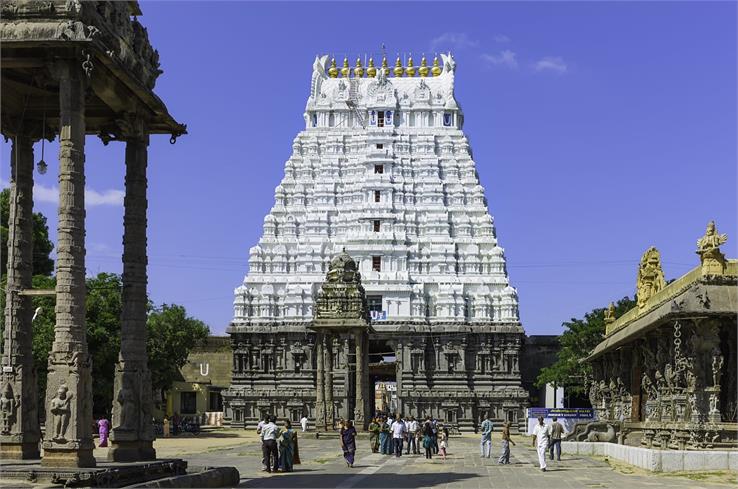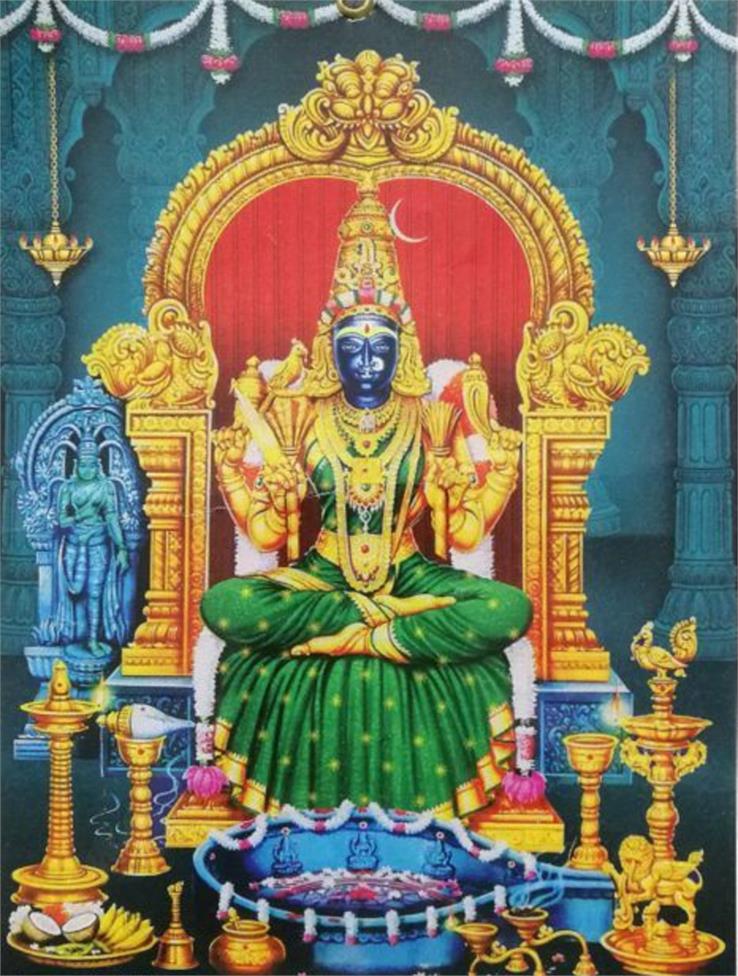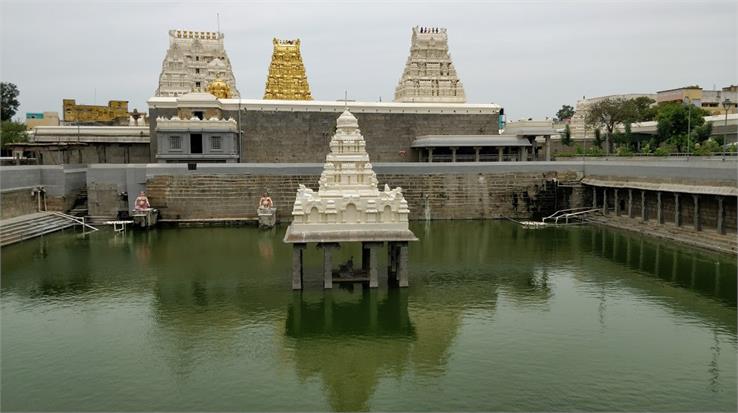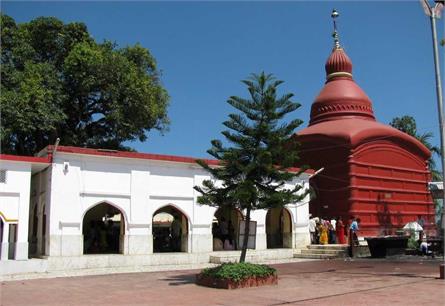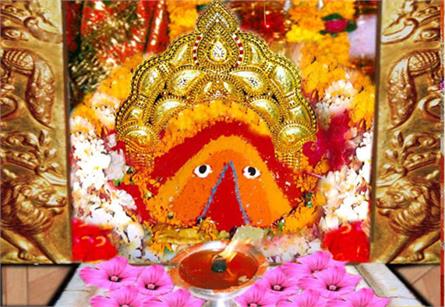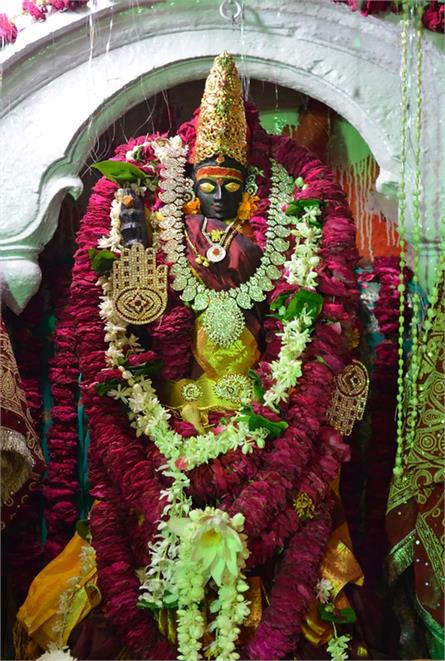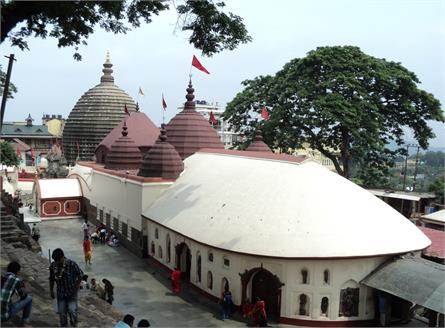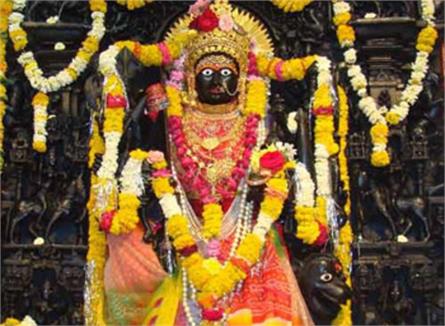Shri Kanchi Kamakshi Amman Temple
One of the ancient Hindu temples in India, Shri Kanchi Kamakshi Amman Temple or also known as Kamakshi Amman, is dedicated to the deity of Kanchi Kamakshi Amman. This holy shrine is one among the 51 Shakti Peethas of the Goddess Sati across the country. Spread across the five acres of land, the temple is situated in the sacred city of Kanchipuram, which is near Chennai in the state of Tamil Nadu, India. Kamakshi Devi is an ultimate form of Goddess Lalitha Maha Tripurasundari, who is a manifestation of Goddess Parvati. The name is derived from the words ‘Ka’ which means Goddess Saraswati (God of Education), ‘Ma’ which means Goddess Lakshmi (God of Wealth), and ‘Aksh’ indicates gracious eyes. On the whole, the name denotes the Goddess who lives in Kanchi possesses Saraswati and Lakshmi as her two eyes.
Also Read: The Divine Power of 12 Jyotirlinga
The naval part of Sati Devi's body is believed to have fallen here.
As the Nama in Lalitha Sahasranamam says, “Sachamara Ramavani Savya Dakshina Saveetha,” which translates as ‘In Kanchipuram, Lakshmi Devi and Saraswathi Devi stand on either side of Kamakshi Devi and perform Vinjamara Seva to Kamakshi Amman.’
It is believed that the Pallava kings made the temple during the sixth century A.D. There are no other Goddess temples in the city of Kanchipuram, apart from this temple.
The deity of Goddess Kamakshi
The Goddess Kamakshi is seated in a Padmasana (a yogic posture), which signifies prosperity and peace and is a resemblance of lotus. The Goddess holds a sugarcane bow in her left lower arm and a bunch of lotus flowers in the right lower arm with a parrot perched near the flower bunch. She also has divine chakras, pasha (lasso), and an Ankusha (goad) in her upper two arms. A Chandraperai (shape of the moon-like structure) is placed near her forehead, and she is always well embellished in beautiful bright saris with the complete shringara.
Also Read: The Mystry of Kamrunag Temple
What history says?
The history reveals that Goddess Kamakshi prayed while standing on one foot on a needlepoint to get married. She was praying under a mango tree with a Shiva lingam made of sand to marry the great Lord Shiva. After a long period of faithful and devoted meditation to Lord Shiva, Lord Shiva appeared and married the Goddess Kamakshi, a divine form of Parvati in the month of Phalgun in the Uttara Nakshatra. There are no conventional Parvati or Shakti temples in the city of Kanchipuram, apart from this shrine, which adds even more folklore to this temple.
Major Devotees
- In ancient times, the Maharaja of Ayodhya, King Dasharatha, performed ‘Putra Kameshti Yagam’ inside the temple premises to have a child for his kingdom. He carried out the ritual at the Nabisthanam of the goddess and received children after a few months. It is also believed that Goddess Kamakshi is a prime deity of the Ikshvaku Vamsam dynasty to which the King Dasharatha belongs. The extract of this story is evident in Markandeya Puranam, and the faith evolved that if the goddess is prayed with utmost devotion, then she blesses childless couples with the child.
- Once, the Saint Adi Shankara, who was born at Kaladi in Kerala, visited Kanchipuram as he had traveled across all parts of the country. Upon his visit, the entire sanctum was very hot, and he felt that the goddess was in her ferocious mode. Therefore, in order to bring her into the normal state, Adi Shankara started praising her with his songs called “Saundarya Lahari” and installed a Sri Chakra in front of her idol to keep her unruffled and personified. That is why she was initially very furious and was depicted as Ugra Swaroopini but later became Shanta Swaroopini at the request of Adi Shankara. The established Sri Chakra is also known as Sri Kanchi Kamakoti Peetham, and the Jagad Guru achieved the Sarvagyna peetham in this holy city.
- A long time ago, there was a devotee named ‘Mookan’ who was dumb came to the holy temple and offered prayers to the goddess for the speech. The goddess was impressed and blessed him with speech and intellect to create poetry. He was very happy and wrote around 500 poems praising the goddess about her beauty and grace; these poems are called “Mookapanchasathi.”
However, just like she blessed the couple with children, made speechless a poet, etc., there is a common belief that whoever worships the goddess with faith and love, Devi Kamakshi brings the prosperity of goodness, blessed with happiness and wealth to all her devotees and destroys the evil.
Also Read: 8 Famous Temples in Indore
Infrastructure

Spreading across an area of 5 acres, the temple houses the Pond and Gaja Shed. The temple has four entrances: the main entrance of the temple has the Mahishasura Mardini deity on the right and a Kala Bhairava deity on its left. There is a huge Dwajasthampa in the center of the entrance, followed by Vinayaga deity. Goddess Kamakshi is sitting in a Padmasana posture, moving in a straight line further. The sanctum houses the Gayatri Mandapam, where the deity of the goddess is placed posture along with the trinity of Shiva, Vishnu, and Brahma. There are smaller shrines of Bangaru Kamakshi, Adi Shankara, and Maha Saraswati around the sanctum. The temple sanctum consists of Varahi, Arupa Lakshmi Kalva Perumal (one of the 108 Vaishnavite deity worship temples), Roopalakshmi, and Arthanareeswarar deities surrounding the Gayatri Mandapam. There is Santhanasthampam, the Nabisthanam of the Goddess inside the prakaram. There is a Sri Chakra Yantra (Sri Kamakoti Peetam) established by Saint Sri Adi Shankaracharya in front of the Goddess deity. Kamakshi temple has a close relation with the Sri Kanchi Kamakoti Peetham and its successive Sankarcharyas. The temple has a gallery that exhibits the life history of Adi Shankaracharya inside the temple premises. The shrine is also signified as “Nabisthana Ottiyana Peetam.” It also has a golden Gopuram on the sanctum of the Goddess Kamakshi deity, which can be seen by all the devotees.
Kamakshi as Lalitha Maha Tripura Sundari
Sri Lalita Parabhattarika reigns over the Kamakoshtha in five forms:
Shri Kamakshi Para Bhattarika
As we have discussed earlier, Shri Kamakshi is seated in the center of the inner sanctum called Gayatri Mandapam. Shri Kamakshi is the Mula devata of the Kamakoti peetha. As per Kamakshi rahasya, this mandapam was created by the celestials with the four walls that signify the four Vedas and the twenty-four pillars epitomize the twenty-four syllables of the sacred mantra of Gayatri. Shri Vidya Parameshvari, who forms the inner essence of the prakata gayatri and thus called rahasya gayatri, is enshrined at the center of the gayatri mandapam in the form of Shri Kamakshi. She is placed on Pancha brahmasana, and Paramba is seated in yoni asana facing southeast. When afflicted by asuras led by Bhandasura, it is said that devas have appeased the Supreme Shakti by performing the penance in the form of parrots residing on champaka vriksham at Kanchi. Later, Paramba was happy with their penance and appeared from her residence in Mahameru or Bilakasha through the bila dvara and demolished the demons. The Shri vigraha of Paramba has been explained in three forms: sthula (Dhyana yogya, Savayava), Sukshma (mantra and yantra maka) as well as Karana or Vasanatmaka. There is also a common belief that Lord Mahadeva himself worshipped paramba in the four yugas believing the forms of sages as Krodha Bhattaraka, Parashurama, Dhaumya, and Adi Shankara Bhagavatpada (and Muka Shankara considered to be an incarnation of krodha bhattaraka). One can see the bila dvara leading to bilakasha in front of the tapomagna kamakshi sannidhi inside the garbhagriha. It is also deemed that Bhagavan Rudra assumed the form of durvasas on her appearance from the bilakasha and worshipped her first through the modalities of srividya tantra by sanctifying a Shri Chakra here. He is the sampradaya guru of srividya, and the credit goes to him for forming paramba at Kanchipuram as Gurumurtisvarupini (Charyanandanatha-para bhattarika mithun atmika). The forms of Vashinyadi Vak Devatas are present around the Srichakra in their same positions as in Shripura. The idols dedicated to Hayagriva and Agastya are situated in the third prakara of the temple, at the location where the teaching of Lalita Trishati was given.
Tapah Kamakshi
This form of paramba is situated on the right of the mula devata and close to the bila dvara. Uma, after the separation from Mahadeva, appeared first as Annapurna in Kashi. Following the advice of sage Katyayana, she worshipped Ekambaranatha under the mango tree in Rudrakoshtha and married him.
Anjana Kamakshi
The shrine of Anjana is on the left of the Mula devata, facing the north direction in front of the Saubhagya Ganapati. She is also known as Arupa Lakshmi. According to history, Rama has performed a penance to regain her lost beauty at this place, which is why kumkuma offerings of Mula devata are presented to her. While she symbolizes Rama in her form as Rama-bija, she represents Kamakshi in the appearance of Kamakalakshara, which is inherent in the Rama-bija.
Svarna Kamakshi
Established in the second prakara, the shrine of Svarna deity is called Banagru Kamakshi. It is believed that this form was created by Shrividya parameshvari from her third eye to serve as the Shakti of ekambaranatha named ekambika. The original idol that has emerged from the third-eye of paramba that used to be an image of Kamakshi in Gold in standing pose is shifted Thanjavur. It was done in order to protect the idol from Muslim attacks by Kamakshidasa, an ancestor of Shri Shyama Shastrigal.
The image is still there in Thanjavur.
Utsava Kamakshi
Located in the second prakara, the idol of Utsava Kamakshi is taken out during processions. The deity is accompanied on either side by idols of Rama and Sharada. In most of the cases, the devatas are generally accompanied by their male/female companions, but here, Kamakshi being Shiva-shaktya mika, there is no shrine dedicated to Lord Shiva. Sri Lalithambika, who emerged from Chidagni for the devastation of Bhandasura, was presented to the world by Brahma with a unique name called ‘Sri Kamakshi.’ Therefore, ‘Kamakshi’ is the special name of the ancient Parashakti Sri Lalita. She is referred to ‘Sri Lalita’ as she brings joy to the mind of Sri Kameshwara.
More Information about the Temple
Pooja Timings
- Abhishekam
The Abhishekam Aarti takes place thrice a day:
Early Morning: 5:30 AM
Morning: 10:30 AM
Evening: 4:00 PM
- Ashtotthara Archana
It happens twice a day:
Morning: 7 AM to 12 Noon
Evening: 6 PM to 8 PM
- Chandana Alankara
It takes place every Wednesday and Saturday at 4:30 PM.
- Navavarana Pooja on Pournami
It takes place after 9:30 PM on a full moon day every month.
- Sahasranaama Archana
This aarti takes place daily twice a day:
Morning: 9 AM to 10 AM
Evening: 7 PM to 8 PM
*During the aartis, the devotees should wear traditional dress while entering into the Gayatri Mandapam.
Entry Fees
There is no entrance fee to get inside the temple.
Temple Timings
| Part of the Day | Timings |
| Morning | 5:30 AM – 12:15 PM |
| Afternoon | Closed |
| Evening | 4:00 PM – 8:15 PM |
*On Fridays, the temple is open till 9:30 PM.
*On Pournami day, it is open till 10:30 PM.
Special Occasions
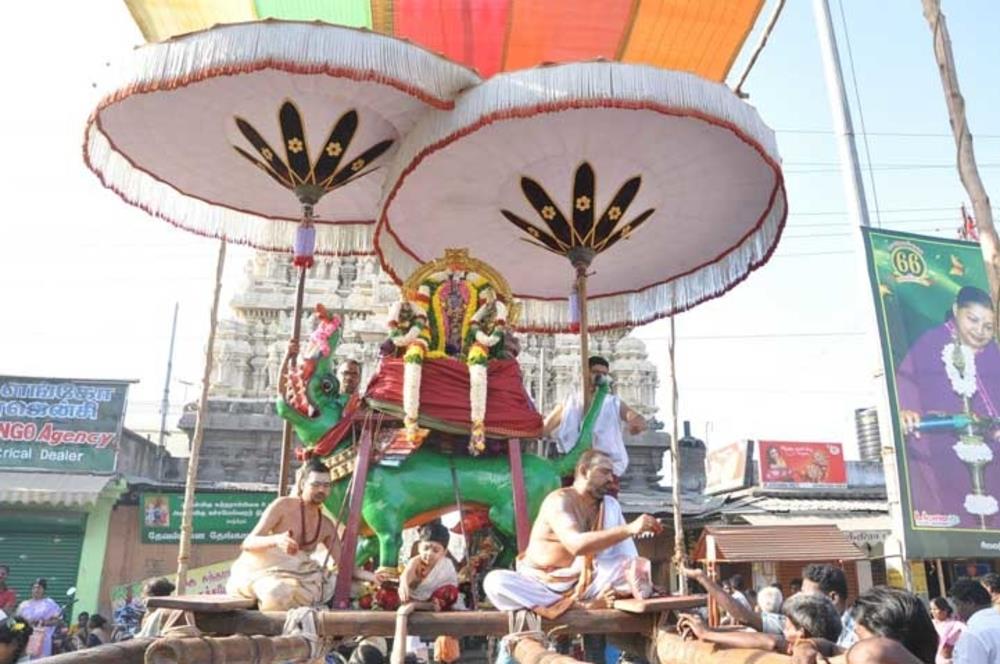
The spring brings the annual festival in the Tamil month of Masi in the months from mid-February to mid-March. The chariot festival (Ther) and float festival (Theppam) are organized during this time. Navaratri, Aadi and Aippasi Pooram, and Vasanta Utsavam are other festivals that fall in the Tamil month of Vaikasi. Other than this, all Fridays are considered sacred, and the Fridays in the Tamil months of Adi (mid-July to mid-August) and Thai (mid-January to mid-February) are celebrated with full joy. Brahmotsavam and Pournami (Full Moon Day) are other notable occasions.
Other places to go around
One of the seven sacred cities in India, Kanchipuram, is most famous for its old temples, silk sarees, and its rich culture and heritage. The city is also known as Temple City, as it boasts numerous holy pilgrimages sites. Some of the places to visit in Kanchipuram are:
- Sri Varadharaja Perumal Temple
- Sri Ulagalanda Perumal Temple
- Sri Kumarakottam Temple
- Sri Kailasanathar Temple
- Sri Kachabeswarar Temple
- Devarajaswami Temple
- Kanchi Kamakoti Peetam
- Ekambaranathar Temple
- Vaikunda Perumal Temple
- Jain Temple, Kanchipuram
- Eri Katha Ramar Temple
How to Reach
By Air
Chennai International Airport is the nearest airport at a distance of about 60 km from the temple.
By Rail
The nearest railhead is the Kanchipuram Railway station at a distance of just 1 km from the temple.
By Road
Kanchipuram is well-connected with the central cities of the state via an extensive network of roads. Regular bus services are available from Chennai (70km), Tirupati (110 km), Pondicherry (124 km), and Tiruchchirappalli (279 km).


